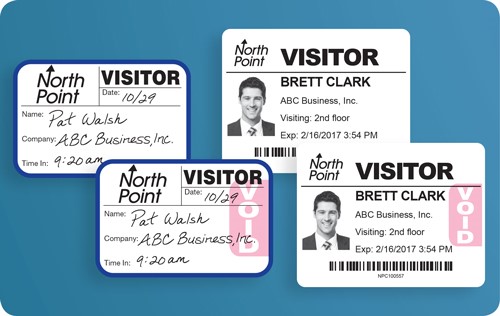Blog
Who has permission to be in your building?
by Andrew Jones

Is he wearing a VALID badge? How can you tell?
Visitor badges that “expire” show your staff who is authorized and who is not.
At a large hospital in Hartford, Conn., a security guard perched on a stool at his post near the entrance to the maternity wing. At fifty years of age, Officer Thompson was well past his football-playing days, but, at six feet tall and over two hundred pounds, he still looked like he could handle any intruder.
As a vendor exited the double doors, another man approached from the other direction. The burly guard held up his hand to the newcomer, who stopped and looked at the officer.
“The visitor badge you are wearing is no good,” Mr. Thompson announced. “You have to go to the front desk and get a new one.”
The visitor, surprised, asked, “What’s wrong with the badge I’m wearing?”
Officer Thompson stood up, stepped around his podium, and pointed at the man’s shirt. “Your badge says “VOID,” he explained. Then, leaning closer for a better look, he added, “and the date is NOT today.” He straightened, widened his stance, and crossed his beefy arms across his chest.
The visitor, exposed by his lapsed badge, examined it as if for the first time. After a few seconds, he slowly turned around and walked toward the main entrance.
A bystander waited a moment before drawing closer to the guard’s station. “That’s pretty cool how you knew that guy wasn’t wearing proper identification.”
“Yup,” Officer Thompson agreed. “These badges definitely work.”
The visitor who Officer Thompson refused to let through was wearing a TAB-Expiring Visitor Pass. The man may have been issued the badge as recently as the day before. But, because it was engineered to change color overnight, the badge showed a pink “VOID” image that could be seen from a distance.
When visitors sign in to a facility that uses TAB-Expiring Visitor Passes, whether by signing into a log book by hand or being registered by computer software, they are issued identification in the form of a label that is unlike any other.
These Visitor Passes “expire” over time to discourage re-use and to prevent re-entry. Before issuing the badge, a receptionist or security guard folds the attached tab behind the label to activate the color-changing process. Once the badge is activated, the process cannot be reversed, and the badge starts to turn color within six to eight hours, completing the change by the following day.


TAB-Expiring Visitor Passes activate easily so they change color over time.
Typically, most people don’t try to re-use a badge that has visibly expired. This removes the need for staff members at the front desk from having to retrieve badges as visitors depart.
Still, hospital personnel are trained to recognize such badges as not having been given out that day. How they respond to such a sighting depends on the hospital’s security protocols. In this case, the security guard had authority to challenge the visitor and deny entry.
(In addition, the label is designed to stick to clothing without harming it. Its fabric-friendly adhesive keeps the visitor I.D. badge securely in place so it doesn’t fall off — not like ordinary labels that are designed to stick to envelopes or shipping cartons.)
Meanwhile, at another facility in Hartford, Saint Francis Hospital and Medical Center, the Director of Security has an equally large campus to protect. Jack Mayoros implemented a manual Visitor Pass sign-in system for when regular visiting hours are over, such as on patient floors, and during normal business hours in one of their physician office buildings using these same TAB-Expiring badges, before switching to the software version, “eVisitorPass.”
“We had experienced an increase in thefts over the prior six to eight months,” Mr. Mayoros recalled. “By funneling people to sign in, and by issuing the visitor pass — getting an I.D. and a name on the person — we cut our thefts to zero in that building. This new I.D. system meets our needs as well as our budget.”
How does your staff tell the difference between a visitor who has authorization and one who does not? Please add your thoughts in the “Comments” section below.
Our article above was originally published here.
Our visitor badges “VOID” overnight to prevent reuse. 
See them for yourself — request free samples!
Posted on 8/3/2016



 Paul Kazlauskas
Paul Kazlauskas
 Andrew Jones
Andrew Jones